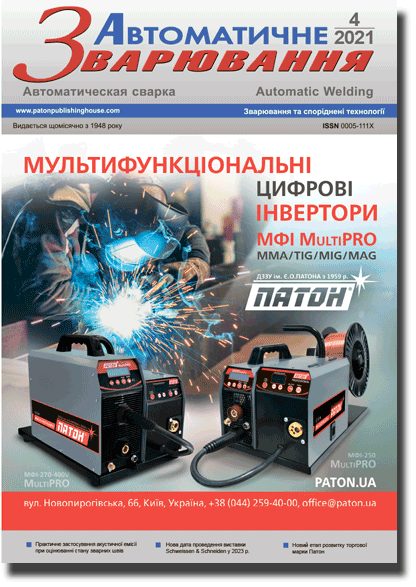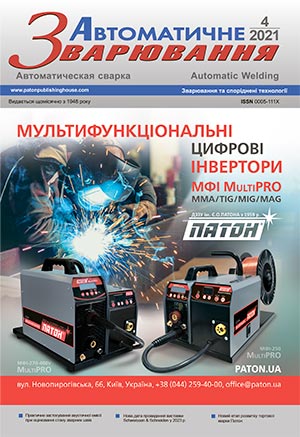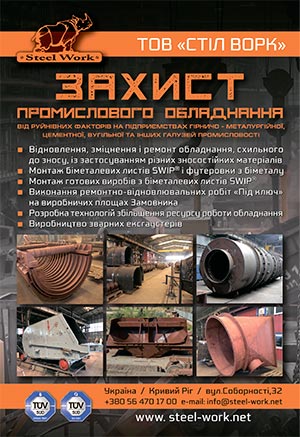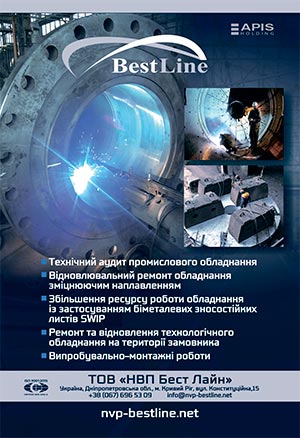| 2021 №04 (03) |
DOI of Article 10.37434/as2021.04.04 |
2021 №04 (05) |
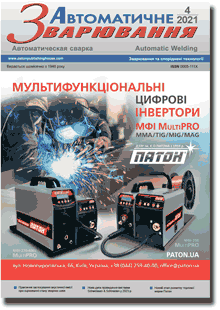
"Avtomatychne Zvaryuvannya" (Automatic Welding), #4, 2021, pp. 23-28
Investigation of heat treatment effect on the strength of Al–Ti bimetal honeycomb core
Yu.V. Falchenko, L.V. Petrushynets, V.Ye. Fedorchuk, Ye.V. Polovetskiy
E.O. Paton Electric Welding Institute of the NAS of Ukraine. 11 Kazymyr Malevych Str., 03150, Kyiv, Ukraine. E-mail: office@paton.kiev.ua
The effect of heat treatment on the strength of aluminium-titanium bimetal honeycomb structures is considered. Aluminuimtitanium bimetal was produced by vacuum diffusion welding of strips of AD1 aluminium and VT1-0 titanium low alloys. The possibility of spot welding of bimetal strips 12 mm wide for producing the honeycomb core was studied with different combinations of titanium and aluminium layers. It is shown that the optimal method is welding the strips in Al/Ti + Al/Ti combination. Here, the average compressive strength of the honeycomb is equal to 41.1 MPa. Annealing of bimetal honeycombs was performed at temperatures of 600 ºС and 700 ºС. Annealing time at 600 ºС was 60…1200 min., at 700 ºС it was 10…30 min. It is found that annealing for 60 min. at 600 ºС leads to formation of individual sites of an intermetallic interlayer up to 1 ~m thick in the butt joint between the aluminium and titanium layers that that results in increase of compressive strength of the honeycomb samples by 11,7 %, compared to the initial condition. Further increase of annealing time leads to growth of the intermetallic interlayer in the butt joint and to lowering of the compressive strength of the honeycomb samples. It is shown that the honeycomb samples after annealing for 60…600 min at 600 ºС at compression with the maximum deformation level of 50 % deform without fracture of the welding site or bimetal material walls. Increase of annealing time leads to embrittlement of both the welding sites, and the material as a whole. 10 Ref., 2 Tabl., 7 Fig. Keywords: aluminium, titanium, foil, bimetal joints, diffusion welding, annealing, intermetallic interlayer, compressive strength
Received: 22.03.2021
References
1. Bitzer, T. (1997) Honeycomb Technology. Materisls, Design, Manufacturing, Applications And Testing. Springer-Science+ Business Media Dordrecht.2. Panin, V.F., Gladkov, Yu.A. (1991) Structures with filler: Refer. book. Moscow, Mashinostroenie [in Russian].
3. Bashurin, A.V., Mastikhin, E.Yu., Kolmykov, V.I. (2010) Diffusion welding of hollow bimetal panels. Zagotovit. Proizvodstvo v Mashinostroenii, 1, 13-15 [in Russian].
4. Falchenko, Ju.V., Petrushynets, L.V., Polovetskii, E.V. (2020) Peculiarities of producing Al-Ti bimetal sheet joints by the method of vacuum diffusion welding. The Paton Welding J., 8, 25-28. https://doi.org/10.37434/tpwj2020.08.04
5. Wadsworth, J., Lesuer, D.R. (2000) Ancient and modern laminated composites - from the Great Pyramid of Gizeh to Y2K. Materials Characterization, 4-5, 289-313. https://doi.org/10.1016/S1044-5803(00)00077-2
6. Karpachev, D.G., Doronkin, E.D., Tsukerman, S.A. et al. (2001) Nonferrous metals and alloys: Refer. book. Nizhny Novgorod, Venta-2 [in Russian].
7. Vasiliev, K.V., Vill, V.I., Volchenko, V.N. et al. (1978) Welding in mechanical engineering: Refer. book. In: 4 Vol., Vol. 1. Moscow, Mashinostroenie [in Russian].
8. Seemann, R. (2020) A Virtual Testing Approach for Honeycomb Sandwich Panel Joints in Aircraft Interior, Springer Vieweg. https://doi.org/10.1007/978-3-662-60276-8
9. Falchenko, Ju.V., Petrushynets, L.V., Polovetskyi, Ye.V. (2020) Peculiarities of producing Al-Ti bimetal sheet joints by the method of vacuum diffusion welding. The Paton Welding J., 8, 25-28. https://doi.org/10.37434/tpwj2020.08.04
10. Falchenko, Ju.V., Petrushynets, L.V., Polovetskii, E.V. (2020) Peculiarities of producing layered metal composite materials on aluminium base. The Paton Welding J., 4, 9-18. https://doi.org/10.37434/tpwj2020.04.02
Advertising in this issue:
The cost of subscription/purchase order journals or individual articles
| Journal/Currency | Annual Set | 1 issue printed |
1 issue |
one article |
| TPWJ/USD | 384 $ | 32 $ | 26 $ | 13 $ |
| TPWJ/EUR | 348 € | 29 € | 24 € | 12 € |
| TPWJ/UAH | 7200 UAH | 600 UAH | 600 UAH | 280 UAH |
| AS/UAH | 1800 UAH | 300 UAH | 300 UAH | 150 UAH |
| AS/USD | 192 $ | 32 $ | 26 $ | 13 $ |
| AS/EUR | 180 € | 30 € | 25 € | 12 € |
| SEM/UAH | 1200 UAH | 300 UAH | 300 UAH | 150 UAH |
| SEM/USD | 128 $ | 32 $ | 26 $ | 13 $ |
| SEM/EUR | 120 € | 30 € | 25 € | 12 € |
| TDNK/UAH | 1200 UAH | 300 UAH | 300 UAH | 150 UAH |
| TDNK/USD | 128 $ | 32 $ | 26 $ | 13 $ |
| TDNK/EUR | 120 € | 30 € | 25 € | 15 € |
AS = «Automatic Welding» - 6 issues per year;
TPWJ = «PATON WELDING JOURNAL» - 12 issues per year;
SEM = «Electrometallurgy Today» - 4 issues per year;
TDNK = «Technical Diagnostics and Non-Destructive Testing» - 4 issues per year.





